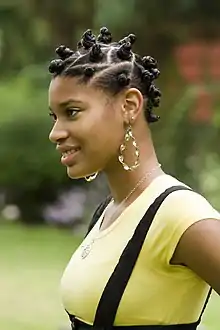Protective hairstyle
A protective hairstyle (a term generally used with reference to Afro-textured hair) is a hairstyle that tucks the hair away and keeps it free from manipulation.[1] Protective hairstyles include braids, dreadlocks, and twists.[2][3][4][5] Afro-textured hair is often prone to breakage or damage from the elements; protective hairstyles aim to guard against this.[6] However, protective hairstyles sometimes involve tension at the scalp, which, if prolonged, may lead to traction alopecia.[7][8] In the United States, some jurisdictions have banned discrimination based on hairstyles associated with African Americans, including protective hairstyles.[9]

Woman with Bantu knots hairstyle, a type of protective hairstyle
References
- "House Report 116-525 - Creating a Respectful and Open World for Natural Hair Act of 2020". U.S. House of Representatives. September 21, 2020. Retrieved November 13, 2020.
- "Protective hairstyles for chilly weather". The Standard. Retrieved November 13, 2020.
- Tarieme, Oreoritse (December 15, 2019). "Protective Hairstyles For When It's Cold". The Guardian. Retrieved November 13, 2020.
- Tarieme, Oreoritse (February 23, 2020). "6 Protective Hairstyles Every Naturalista Should Know". The Guardian. Retrieved November 13, 2020.
- "5 hairstyles to protect your natural hair this summer". Independent Online. December 4, 2018. Retrieved November 13, 2020.
- Oré, Michella (November 7, 2020). "31 Cool Protective Hairstyles You'll Want to Try This Year". Glamour. Retrieved November 13, 2020.
- Perry, Jamyra (July 25, 2020). "New documentary says protective hairstyles are hurting Black women". The Philadelphia Tribune. Retrieved November 13, 2020.
- Hawkins, LaParis (November 11, 2013). "Natural Hair Now: Basic Hair Care Dos and Don'ts". Ebony. Retrieved November 13, 2020.
- Ronayne, Kathleen (July 4, 2019). "California becomes 1st state to ban hairstyle discrimination". Associated Press. Retrieved November 13, 2020.
This article is issued from Wikipedia. The text is licensed under Creative Commons - Attribution - Sharealike. Additional terms may apply for the media files.